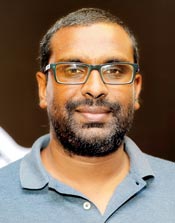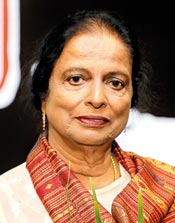A tale of horror that fills a gaping lacuna of the 87-90 period
In Vihanga Perera’s novel Students and Rebels, the controversial writer (who couldn’t be nicer and more charming in real life), revisits the dark days of the 1987-1990 political emergency focusing on two Kandyan villages in the grip of terror.
 Vihanga himself was three when the situation turned dark and bloody and recalls men coming to collect identity cards on a night, also curfews and holidays, stories of some villagers (particularly, Banda who lived not too far from his childhood home) being shot and killed, and protests being attacked by the police and military.
Vihanga himself was three when the situation turned dark and bloody and recalls men coming to collect identity cards on a night, also curfews and holidays, stories of some villagers (particularly, Banda who lived not too far from his childhood home) being shot and killed, and protests being attacked by the police and military.
“One vivid memory from the time has to do with my mother taking me on a walk one evening down the village road (it was probably late in ’87). There was a small house at a bend and just as we came there the front door opened and a tall charismatic man stepped out. Turning to us across the road he gave a smile only a film star or politician can give. It was Vijaya Kumaratunga! And as we know, Vijaya was gunned down early in ’88 which couldn’t have been too long after. This story, of course, is not in ‘Students and Rebels’.
“It is a story for another book.”
Vihanga believes that the riots have not been unearthed enough creatively apart from in a few films like Rahas Kiyana Kandhu, Paangshu, Ginnen Upan Seethala and Ajith Perakum Jayasinghe’s compelling auto-fictional work titled K-Point.
A lot of research preceded the book. This included what Vihanga calls ‘pro-establishment material’, but also a welter of de-centring/ counter-narrative effort including Prins Gunasekera’s “A Lost Generation: Lanka in Crisis: The Untold Story” and works of Rohitha Munasinghe, Kularatne Kurukulasuriya (who, with Kanchana Madhavi, wrote a book on the Embilipitiya massacres), and Rohitha Bhashana Abeywardena, now in exile.
Five narrators take up the tale of horror. They are fictional, but their stories and the energy they represent are real, says Vihanga.
“Some of it is historically verifiable and supported by local lore found in each village and town. Yet others – like abductions, disappearances, show killings, psychologically scarred survivors – are hallmarks of the 1987-90 violence.”
The two villages, Dodanwala and Halloluwa, are on either side of the Mahaweli river where it flows between Gannoruwa and Katugastota. In Vihanga’s mind the bridge between the two villages, a colonial-era construction suspended on cables, was central to his youthful impressions of the riots.
The book took two and a half years and four or five carefully reviewed drafts. Says Vihanga, “I am quite satisfied with the kind of experiment I bring into the overall construction of the story, and the way in which I present the individual viewpoints of the five story-tellers.”
The book fills a gaping lacuna. As Vihanga says, “Most of the histories of the time are recorded in Sinhala resulting in their being held up from readers who only read English. This is, perhaps, one reason why the impressions of 1987-90 are mostly felt by English readers in the country as already having been accounted for. Stories of 1987-90 that are available in English are dominated by two or three writers who wrote defending the state-position during that time.”
This is Vihanga’s fourth Gratiaen shortlisting. He won the prize in 2014 for his collection of poetry Love & Protest.
Life lessons from her mother the driving force of her book
Selvi Sachithanandam, though a product of St. Bridget’s Convent, Colombo, grew up partly in Jaffna and was nourished by old Hindu fables and parables so beloved of earlier generations.
 The book – initially an attempt to come to terms with her mother’s death – embraces five generations of women in the family, and charts a history that begins in the era of British Ceylon. It delves into the spicy details of housekeeping in those inner courtyard kitchens, caste practices and gender relations in the Dravidian world hemmed by palmyrah fences.
The book – initially an attempt to come to terms with her mother’s death – embraces five generations of women in the family, and charts a history that begins in the era of British Ceylon. It delves into the spicy details of housekeeping in those inner courtyard kitchens, caste practices and gender relations in the Dravidian world hemmed by palmyrah fences.
Selvi gained graduate and postgraduate education in architecture, town planning and development planning and worked as an architect and town planner abroad. She is passionate about history, storytelling and creative writing.
Her narrative interspersed with legend and parable, begins in the early part of the 20th Century, and takes on the divisive politics of the 1950s, the rise and fall of the Samasamajists, the ’58 riots, Black July, the war and the end of the war in Mullivaikkal.
But the ‘driving force’ of the book says Selvi, are the life lessons from her mother. “This book bespeaks how to love, find real and lasting happiness, and live a beautiful, purposeful life even in the midst of war, conflict, and injustice. The wisdom in this book can inspire and instruct any reader of any background.”
The ‘spiritual thread’ running through the book makes lessons of how Gnanam responded to life situations – “the important choices she makes, equanimity in extending her circle of love to include other people and the importance placed on the web of relationships over money and property.”
Says Selvi, “The book asserts that we are part of a whole and here to serve humanity. This world view aligns the thoughts and emotions impacting emotional and mental wellbeing in people. Ayurveda reinforces this by “Kshamavaan aapthopasevi bhaveth”- health happens when you treat everyone around you as near and dear.”
The dignity and grace of a matriarch through life is admired but even more impressive is how she met death.
“…She chose the time of death and how to exit this world. Her fourteen day fast without food or water and the final peaceful exit are the ultimate affirmation of her wisdom and spirituality.”
One reader at least, found this last detail beneficial, confessing that she ‘lost the fear of death’. Others were to testify to a ‘shift in consciousness’ after reading the book.
The book entailed a lot of research on “historic events and consultations with family…- to corroborate the verbal narration”.
The book was a labour of love shared with Selvi’s daughter Dhivya who contributed in no small part to the tapestry of a lost age and its eternal wisdom.
Selvi, who after returning home, was glad to work as a senior programme officer with the UN, also founded the Poornam Foundation on spirituality, healing and meditation which spearheaded a project to assist war widows in Kilinochchi.
Searching for an ideal partner? Find your soul mate on Hitad.lk, Sri Lanka's favourite marriage proposals page. With Hitad.lk matrimonial advertisements you have access to thousands of ads from potential suitors who are looking for someone just like you.


